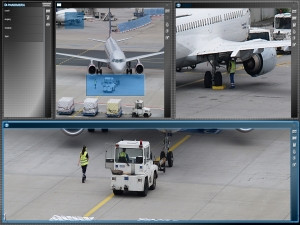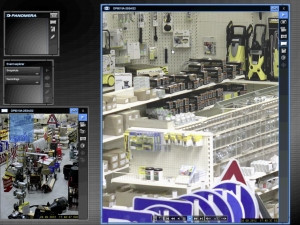
The technological advances that have been made in the field of network-based surveillance in the last few years are astounding. High-definition and megapixel cameras were introduced to the market and the question arose: Which are more suitable for professional video surveillance, HD cameras or megapixel cameras? But since then, even that discussion is already outdated: A new technology, known as multi-focal sensor technology, has taken the market by storm and is paving the way for a whole range of hitherto inconceivable surveillance and analysis capabilities.
When the first HD and megapixel cameras were launched into the market a few years ago, they were clearly superior to the predecessor SD cameras, with much higher resolutions. HD cameras are impressive because of a technology that is derived from the field of video - that is to say relating to moving images. On the other hand, the roots of megapixel technology are in the field of static photography, even though they can reach higher pixel values than are possible with HD cameras. But before any discussions begin as to whether HD or megapixel cameras are more suitable for modern surveillance tasks, one point must be considered: Resolution on its own is not everything. In order to be able to use the images from surveillance cameras efficiently and analyse them successfully, other dimensions besides resolution are important, such as effective image breakdown, recording of the overall image or analysis in the past. Whereas both HD and megapixel cameras very soon reach the limits of their capabilities in these areas, multi-focal sensor technology performs flawlessly.
Unlike HD and megapixel cameras, which are equipped with a single lens, the multi-focal sensor systems work with several lenses, each of which has a different focal length. Thanks to this new sensor concept, the camera can be adapted optimally to the area for surveillance, so details are still clearly visible, not only close up, but also at very long distances, and individuals can be recognised. However, that is not the only way it stands apart from conventional cameras.
Efficient image breakdown
One of the main arguments advanced by the defenders of high-definition cameras is that HD uses the widescreen format with an aspect ratio of 16:9, compared with the 4:3 format of the megapixel cameras. This corresponds more closely to the human field of vision, and makes it possible to record yet more information laterally as well.
But real scenes seldom correspond to either of these two formats. However, in order to cover all areas of interest, it is often accepted that unimportant expanses, such as the sky, will be captured as well. In this case, pixels, and the recording and storage capacity they take up, are all wasted needlessly. But there is a more elegant solution: instead of forcing a scene for surveillance into a given format, with multi-focal sensor systems, there are no rigid, pre-set aspect ratios. They adapt the pixel ratio to the situation at hand! The image is split efficiently without being locked into specific aspect ratios, such as 16:9 or 4:3. Thus, for example, aspect ratios like 5:1, 10:1 or 3:4 can be used without any difficulty.
Constant resolution over the entire object space
It is true that HD and megapixel cameras use progressive resolution options, but they quickly reach their limits precisely when it is important to be able to recognise details even at long distances. "Movies or television series like CSI often suggest to viewers that even blurry pictures can be transformed into high-quality police 'wanted' posters with just a few clicks," explains Roland Meier, Team Leader, Panomera Multifocal Sensor Systems, at Dallmeier. "But pixels are still just pixels: if there is no additional image information present, for example, because an HD or MP camera only represents a person at a distance of 50m with a collection of coarse blocks, this information also cannot be conjured out of thin air after the fact. So you are aware that something is happening here, but it is completely impossible to even recognise, much less identify a person. And that is precisely the objective of a professional video system."
So in order to obtain the desired information, in the past multiple cameras had to be installed at different locations. But this in turn involves higher costs: The appropriate cabling for power supply and data transmission is needed at every individual installation site, so the infrastructure costs and subsequent maintenance costs for multiple camera sites are enormous.
This is where the new multi-focal sensor technology can help, since the resolution it offers is currently about 32 times greater than a conventional HD camera. It can be used from just a single installation point to provide surveillance of a huge area. "With conventional cameras, the resolution drops off as distance increases. Or to put it another way: The farther a person or object is away from the camera location, the poorer the resolution there is, so you are able to make out fewer details. In contrast, a multi-focal sensor system uses different lenses, so constant resolution can be guaranteed over the entire area under surveillance. So the resolution at 100m is exactly as good as it is at 20m. This makes it possible to recognise people, for example, even from 160m," declares Meier.
Permanent recording of the total picture in highest resolution
Those who have no desire to install multiple conventional cameras over the area in question, as described previously, can use "PTZ" cameras. As their name suggests, these cameras can "Pan, Tilt and Zoom". So in theory it would be possible to use these cameras to watch over a relatively large area and to pan or zoom to a location of interest if the need arises. But PTZ cameras have one critical disadvantage: They only ever record what the operator is currently seeing live. So if the user zooms in on a certain scene, it is only this scene that will be recorded. Any additional incidents in the viewing range of the PTZ camera are lost and cannot be analysed or proven subsequently. Accordingly, the surveillance system is only as good as the user who is operating it.

In contrast, a multi-focal sensor system always delivers total performance, since the whole picture ("permanent and overall") is constantly recorded in highest resolution. "Those are three important points straight away: the whole picture is recorded, so no areas are lost, even if the operator is currently concentrating on a smaller inset. This total picture is recorded all the time, so there are no gaps in time. And finally: the recording takes place in the highest resolution, so no details are lost in the recording," says Meier.
"Moreover, unlike PTZ cameras, multi-focal sensor systems do not have any mechanical parts, so there is no wear, which extends the equipment's operating life significantly. And there is another advantage: whereas with PTZ cameras only one operator can have control over the camera at a time, with the multi-focal sensor system, any number of users can connect to the camera and select their entirely individual views," he adds.
Analysis in the past
Seeing live images from the surveillance cameras is one thing - but with professional video security systems, most analyses take place in the past. This means the video system runs, and if an incident should occur at a given time, the recordings are searched for later in order to reconstruct the course of events and identify the individuals responsible.
Consequently, it is an essential requirement of modern surveillance systems that they are also able to zoom or pan even in the recordings. With conventional HD or MP equipment, this is not possible. "Even with PTZ cameras, these functions are only possible in live mode, not subsequently, in the recording. And if the operator is concentrating live on another area in the surveillance scene at the precise time, the entire incident will not be seen on the video images," states Meier. "So video surveillance becomes a game of chance in the truest sense of the word. For example, if you want to identify a car thief in a car park with a PTZ camera, you would have had to zoom in to the car in question before the theft took place, in order to record the crime in adequate resolution. So how likely is it that you would just happen to catch someone in the act like that?"
Here too, the solution is available with multi-focal sensor systems, because all PTZ functions are fully available, even in the past - even as the system continues recording images live. Meier explains: "Since the overall image was recorded at the highest possible resolution, it is also possible to move within the image and to zoom in on pertinent details. This opens up a wide range of analysis options, which were simply not possible with the prior technology."
Share
Dallmeier
Dallmeier has at its disposal more than 25 years' of experience in transmission, recording as well as picture processing technology and is an outstanding pioneer of CCTV/IP solutions worldwide. This profound knowledge is used in the development of intelligent software and high-quality recorder and camera technologies, enabling Dallmeier to not only offer standalone systems, but complete network solutions up to large-scale projects with perfectly integrated components. Right from the beginning, the company always focused on own innovative developments and highest quality and reliability. Dallmeier is the only manufacturer in Germany that develops and manufactures all components on its own. This includes the entire product range, from cameras to picture storage and transmission, to intelligent video analysis and even individually adjusted management systems. Quality made by Dallmeier, made in Germany!
Over the years, Dallmeier has repeatedly given fresh impetus to the market with new developments and extraordinary innovations. The world's first DVR, for example, which introduced digital recording to the entire CCTV industry, came from Dallmeier. The multi-focal sensor system, Panomera, will have a similarly ground-breaking effect: This unique and novel camera technology will revolutionise the market and open up completely new possibilities to the video security industry. This and the extensive experience in the CCTV and IP field have led to a top position in the international market for digital video surveillance systems.
www.dallmeier.com
www.panomera.com
www.caminpix.com
www.casino-surveillance.com
www.videonetbox.com
Editorial contacts